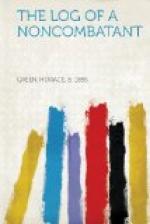It was the night before that I had wandered into Ghent alone, without even the excitement of getting arrested. Luther, who became restive early the next morning while I was jotting notes in the log-book, went off in search of adventure. Because of the influence exerted by Vice-Consul Van Hee an arrangement was very soon made whereby a Belgian Government car and chauffeur were placed at our disposal. We had no laissez-passer for the firing line; but we were accompanied by the United States Consul and not governed by any stipulation as to our destination. In our Belgian car, decorated with all the American flags we could find, and “American Consular Service” pasted in huge letters on the windshield and side flaps, we raced along the Boulevard de l’lndustrie, swung into the southern suburbs, and, once outside the city limits, we opened up the exhaust and threw down the throttle as Van Hee shouted out the order:—“To Termonde!”
Termonde was at that time the scene of determined fighting between units of the ninth German Corps and the Belgian defenders. Situated as it is, twenty-one miles southeast of Ghent, it marks the southwest corner of a square formed by Louvain and Termonde on the south, by Ghent and Antwerp on the north. It controlled the bridge over the River Scheldt and with it an important approach to Antwerp, the capital at that time of Belgium. The heavy German siege guns, capable of demolishing a first-class fort at a range of several miles, could not have crossed the river so easily at any other point. For this reason the Germans particularly wanted Termonde—an open bridge to Antwerp was always worth the taking. The town had already at that time been captured and recaptured; wounded and refugees were swarming into Ghent full of battle stories and tales of terrible atrocities. So it was Termonde that we vowed we would see.
We first saw Verhagen trudging in the same direction as ourselves on the level, dusty road two miles southwest of Ghent. As we approached a cross-road marked by a tavern, a couple of direction-posts, and nondescript stucco buildings, we made out two Belgian sentries, with their rifles lifted overhead and indulging in some acrobatic exercises which we interpreted as a signal to halt. Van Hee swapped cigarettes with them and gossiped in their native tongue, in return for which they gave us some good advice. They warned us to pay no attention to sign-posts, which, in order to fool the enemy, were either marked with false names or else were pointed in the wrong direction. While we were talking, a tall gray alderman came along the road with a greasy package under his arm and at his side a priest—one of those ubiquitous black-robed figures with a hat like an inverted oatmeal bowl.
“Where to?” asked the Vice-Consul of Ghent.
“A Dendermonde,” (to Termonde), answered Verhagen, sizing us up as strangers, and using French instead of the local Flemish dialect.




